动名词的特殊句型及用法
- 格式:ppt
- 大小:313.00 KB
- 文档页数:28

动名词的用法动名词是一种兼有动词和名词特征的非限定动词。
它可以支配宾语,也能被副词修饰。
动名词有时态和语态的变化。
一、动名词的作用动名词具有名词的性质,因此在句中可以做主语、表语、宾语、定语等。
1、做主语Reading is an art. 读书是一种艺术。
Climbing mountains is really fun. 爬山是真有趣。
Working in these conditions is not a pleasure but a suffer. 在这种工作条件下工作不是愉快而是痛苦。
动名词做主语,有时先用it作形式主语,把动名词置于句末。
这种用法在习惯句型中常用。
如:It is no use/no good crying over spilt milk. 洒掉的牛奶哭也没用。
It is a waste of time persuading such a person to join us. 劝说这样的人加入真是浪费时间。
It was hard getting on the crowded street car. 上这种拥挤的车真难。
It is fun playing with children. 和孩子们一起玩真好。
There is no joking about such matters. 对这种事情不是开玩笑。
2、作宾语(1)作动词的宾语某些动词后出现非限定性动词时只能用动名词作宾语,不能用不定式。
常见的此类动词有:advise, allow, permit, avoid, consider, enjoy, finish, give up, cannot help, imagine, include, keep, keep on, mind, miss, put off, delay, practise, resist, suggest, depend on, think about, set about, succeed in, worry about, burst out, insist on, can’t stand, be used to, get used to, devote…to…, look forward to, pay attention to, get down to等。
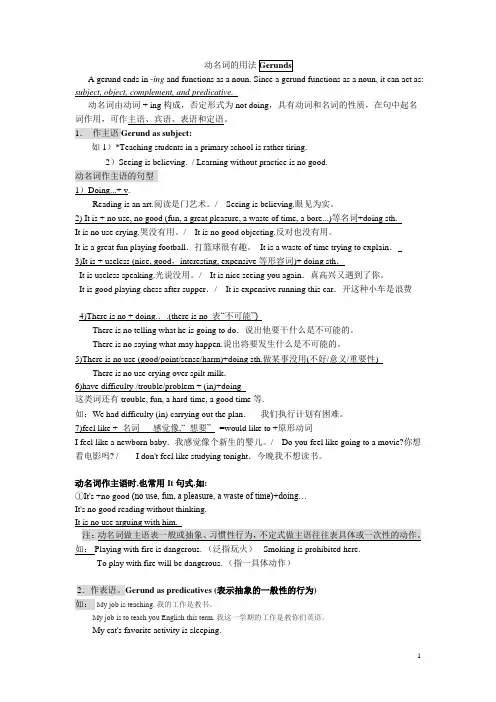
动名词的用法A gerund ends in -ing and functions as a noun. Since a gerund functions as a noun, it can act as: subject, object, complement, and predicative.动名词由动词 + ing构成,否定形式为not doing,具有动词和名词的性质,在句中起名词作用,可作主语、宾语、表语和定语。
1.作主语Gerund as subject:如1)*Teaching students in a primary school is rather tiring.2)Seeing is believing. / Learning without practice is no good.动名词作主语的句型1)Doing...+ v.Reading is an art.阅读是门艺术。
/ Seeing is believing.眼见为实。
2) It is + no use, no good (fun, a great pleasure, a waste of time, a bore...)等名词+doing sth.It is no use crying.哭没有用。
/ It is no good objecting.反对也没有用。
It is a great fun playing football.打篮球很有趣。
It is a waste of time trying to explain.3)It is + useless (nice, good,interesting, expensive等形容词)+ doing sth.It is useless speaking.光说没用。
/ It is nice seeing you again.真高兴又遇到了你。
It is good playing chess after supper./ It is expensive running this car.开这种小车是浪费4)There is no + doing...(there is no 表“不可能”)There is no telling what he is going to do.说出他要干什么是不可能的。

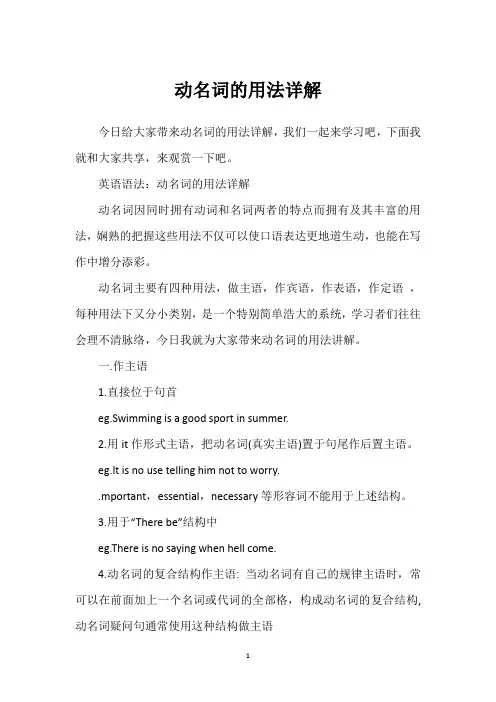
动名词的用法详解今日给大家带来动名词的用法详解,我们一起来学习吧,下面我就和大家共享,来观赏一下吧。
英语语法:动名词的用法详解动名词因同时拥有动词和名词两者的特点而拥有及其丰富的用法,娴熟的把握这些用法不仅可以使口语表达更地道生动,也能在写作中增分添彩。
动名词主要有四种用法,做主语,作宾语,作表语,作定语,每种用法下又分小类别,是一个特别简单浩大的系统,学习者们往往会理不清脉络,今日我就为大家带来动名词的用法讲解。
一.作主语1.直接位于句首eg.Swimming is a good sport in summer.2.用it作形式主语,把动名词(真实主语)置于句尾作后置主语。
eg.It is no use telling him not to worry..mportant,essential,necessary等形容词不能用于上述结构。
3.用于“There be”结构中eg.There is no saying when hell come.4.动名词的复合结构作主语: 当动名词有自己的规律主语时,常可以在前面加上一个名词或代词的全部格,构成动名词的复合结构,动名词疑问句通常使用这种结构做主语eg.Their coming to help was a great encouragement to us.Does your saying that mean anything to him?二.作宾语1.作动词的宾语某些动词后消失非限定性动词时只能用动名词作宾语,不能用不定式。
不定式通常指某种特定的动作,但动名词表示泛指,常见的此类动词有:admit,appreciate,excuse,stand,advise,allow,permit,avoid,consider,enjoy,f inish,give up,cannot help,imagine,include,keep,understand,keepon,mind,report,risk,miss,put off,delay,practise,resist,suggest,depend on,think about,set about,succeed in,worry about,burst out,insist on,feel like,be used to,get used to,devote…to…,look forward to,pay attention to,get down to,escape and so on.eg.They went on walking and never stopped talking.他们连续走,说个不停。
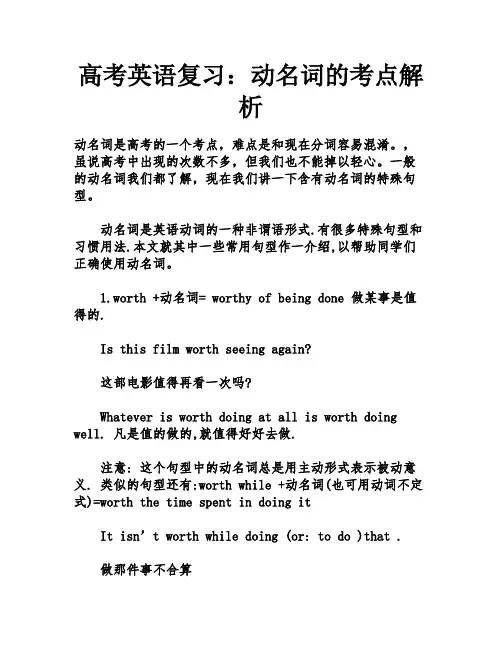
高考英语复习:动名词的考点解析动名词是高考的一个考点,难点是和现在分词容易混淆。
,虽说高考中出现的次数不多,但我们也不能掉以轻心。
一般的动名词我们都了解,现在我们讲一下含有动名词的特殊句型。
动名词是英语动词的一种非谓语形式.有很多特殊句型和习惯用法.本文就其中一些常用句型作一介绍,以帮助同学们正确使用动名词。
1.worth +动名词= worthy of being done 做某事是值得的.Is this film worth seeing again?这部电影值得再看一次吗?Whatever is worth doing at all is worth doing well. 凡是值的做的,就值得好好去做.注意: 这个句型中的动名词总是用主动形式表示被动意义. 类似的句型还有:worth while +动名词(也可用动词不定式)=worth the time spent in doing itIt isn’t worth while doing (or: to do )that .做那件事不合算2.cannot help +动名词=be unable to refrain from doing ---不禁;忍不住;不得不He couldn’t help laughing when he heard the funny story.他听到这个滑稽故事时,忍不住大笑起来.注意: 类似的惯用句型还有: cannot stand /bear +动名词I can’t stand waiting any longer.再等下去我可受不了I won’t bear your talking to me like that.我不能忍受你跟我那样谈话.3.feel like+动名词 =be inclined to do ----想要Do you feel like taking a walk with me?跟我一起去散步怎么样?He doesn’t take care of his eats what he feels like eating.他不注意健康;想要吃什么就吃什么。
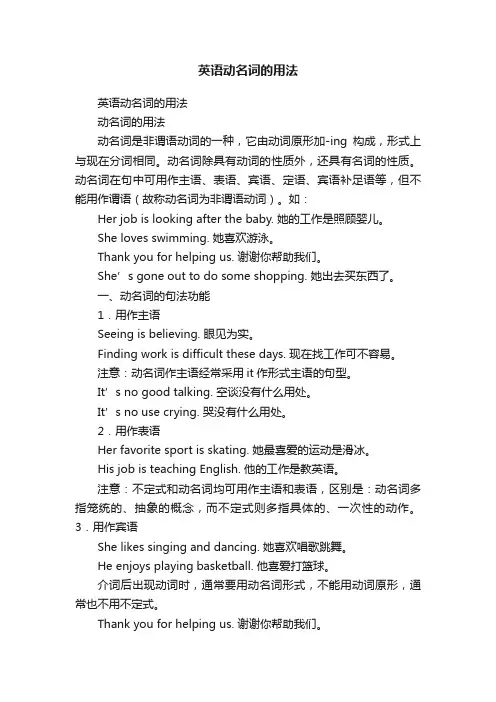
英语动名词的用法英语动名词的用法动名词的用法动名词是非谓语动词的一种,它由动词原形加-ing构成,形式上与现在分词相同。
动名词除具有动词的性质外,还具有名词的性质。
动名词在句中可用作主语、表语、宾语、定语、宾语补足语等,但不能用作谓语(故称动名词为非谓语动词)。
如:Her job is looking after the baby. 她的工作是照顾婴儿。
She loves swimming. 她喜欢游泳。
Thank you for helping us. 谢谢你帮助我们。
She’s gone out to do some shopping. 她出去买东西了。
一、动名词的句法功能1.用作主语Seeing is believing. 眼见为实。
Finding work is difficult these days. 现在找工作可不容易。
注意:动名词作主语经常采用it作形式主语的句型。
It’s no good talking. 空谈没有什么用处。
It’s no use crying. 哭没有什么用处。
2.用作表语Her favorite sport is skating. 她最喜爱的运动是滑冰。
His job is teaching English. 他的工作是教英语。
注意:不定式和动名词均可用作主语和表语,区别是:动名词多指笼统的、抽象的概念,而不定式则多指具体的、一次性的动作。
3.用作宾语She likes singing and dancing. 她喜欢唱歌跳舞。
He enjoys playing basketball. 他喜爱打篮球。
介词后出现动词时,通常要用动名词形式,不能用动词原形,通常也不用不定式。
Thank you for helping us. 谢谢你帮助我们。
He left without saying good-bye. 他没有告别就离开了。
4.用作定语This is our reading room. 这时我们的阅览室。
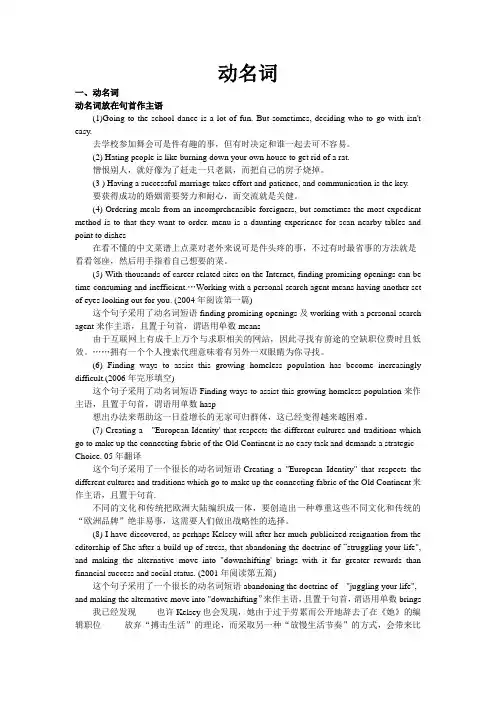
动名词一、动名词动名词放在句首作主语(1)Going to the school dance is a lot of fun. But sometimes, deciding who to go with isn't easy.去学校参加舞会可是件有趣的事,但有时决定和谁一起去可不容易。
(2) Hating people is like burning down your own house to get rid of a rat.憎恨别人,就好像为了赶走一只老鼠,而把自己的房子烧掉。
(3 ) Having a successful marriage takes effort and patience, and communication is the key.要获得成功的婚姻需要努力和耐心,而交流就是关健。
(4) Ordering meals from an incomprehensible foreigners, but sometimes the most expedient method is to that they want to order. menu is a daunting experience for scan nearby tables and point to dishes在看不懂的中文菜谱上点菜对老外来说可是件头疼的事,不过有时最省事的方法就是看看邻座,然后用手指着自己想要的菜。
(5) With thousands of career-related sites on the Internet, finding promising openings can be time-consuming and inefficient.…Working with a personal search agent means having another set of eyes looking out for you. (2004年阅读第一篇)这个句子采用了动名词短语finding promising openings及working with a personal search agent来作主语,且置于句首,谓语用单数means由于互联网上有成千上万个与求职相关的网站,因此寻找有前途的空缺职位费时且低效。
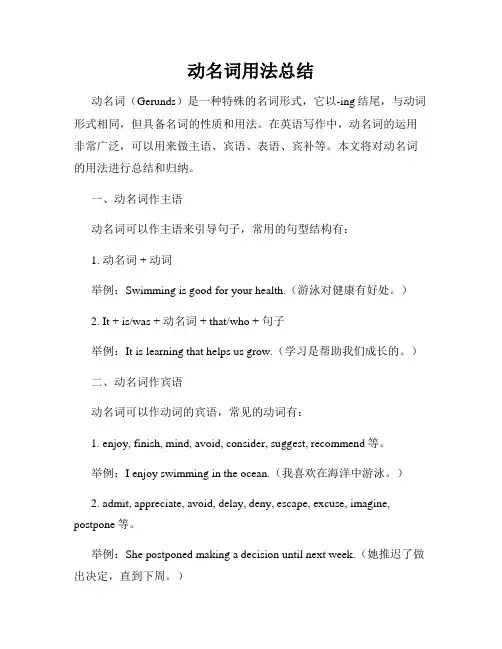
动名词用法总结动名词(Gerunds)是一种特殊的名词形式,它以-ing结尾,与动词形式相同,但具备名词的性质和用法。
在英语写作中,动名词的运用非常广泛,可以用来做主语、宾语、表语、宾补等。
本文将对动名词的用法进行总结和归纳。
一、动名词作主语动名词可以作主语来引导句子,常用的句型结构有:1. 动名词 + 动词举例:Swimming is good for your health.(游泳对健康有好处。
)2. It + is/was + 动名词 + that/who + 句子举例:It is learning that helps us grow.(学习是帮助我们成长的。
)二、动名词作宾语动名词可以作动词的宾语,常见的动词有:1. enjoy, finish, mind, avoid, consider, suggest, recommend等。
举例:I enjoy swimming in the ocean.(我喜欢在海洋中游泳。
)2. admit, appreciate, avoid, delay, deny, escape, excuse, imagine, postpone等。
举例:She postponed making a decision until next week.(她推迟了做出决定,直到下周。
)三、动名词作表语动名词可以作表语,常与be动词连用,表示主语的特征或状态。
举例:Her hobby is painting.(她的爱好是绘画。
)举例:My dream is traveling around the world.(我的梦想是环游世界。
)四、动名词作宾补在某些动词后面,可以加上动名词作宾补来表示动作的完整性。
常见的动词有:see, watch, hear, feel, notice, observe等。
举例:I saw him crossing the street.(我看到他穿过马路。
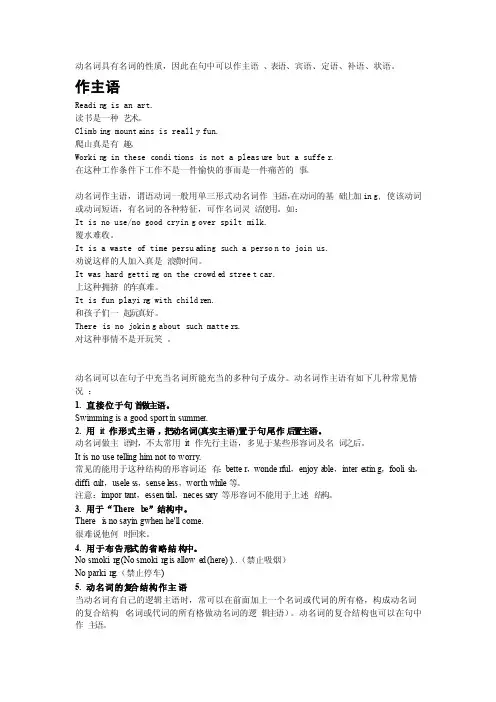
动名词具有名词的性质,因此在句中可以作主语、表语、宾语、定语、补语、状语。
作主语Readin g is an art.读书是一种艺术。
Climbi ng mounta ins is really fun.爬山真是有趣。
Workin g in thesecondit ionsis not a pleasu re but a suffer.在这种工作条件下工作不是一件愉快的事而是一件痛苦的事。
动名词作主语,谓语动词一般用单三形式动名词作主语,在动词的基础上加ing , 使该动词或动词短语,有名词的各种特征,可作名词灵活使用。
如:It is no use/no good crying over spiltmilk.覆水难收。
It is a wasteof time persua dingsuch a person to join us.劝说这样的人加入真是浪费时间。
It was hard gettin g on the crowde d street car.上这种拥挤的车真难。
It is fun playin g with childr en.和孩子们一起玩真好。
Thereis no joking aboutsuch matter s.对这种事情不是开玩笑。
动名词可以在句子中充当名词所能充当的多种句子成分。
动名词作主语有如下几种常见情况:1. 直接位于句首做主语。
Swimmi ng is a good sportin summer.2. 用it 作形式主语,把动名词(真实主语)置于句尾作后置主语。
动名词做主语时,不太常用it 作先行主语,多见于某些形容词及名词之后。
It is no use tellin g him not to worry.常见的能用于这种结构的形容词还有:better,wonderful,enjoya ble,intere sting,foolish,diffic ult,useless,sensel ess,worthwhile等。
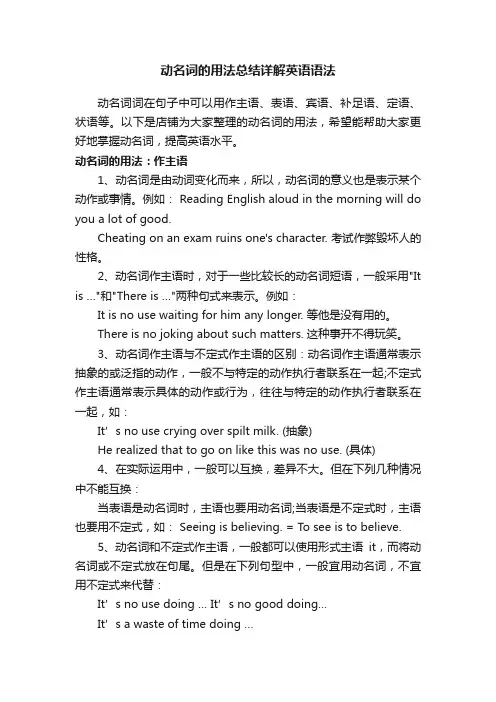
动名词的用法总结详解英语语法动名词词在句子中可以用作主语、表语、宾语、补足语、定语、状语等。
以下是店铺为大家整理的动名词的用法,希望能帮助大家更好地掌握动名词,提高英语水平。
动名词的用法:作主语1、动名词是由动词变化而来,所以,动名词的意义也是表示某个动作或事情。
例如: Reading English aloud in the morning will do you a lot of good.Cheating on an exam ruins one's character. 考试作弊毁坏人的性格。
2、动名词作主语时,对于一些比较长的动名词短语,一般采用"It is …"和"There is …"两种句式来表示。
例如:It is no use waiting for him any longer. 等他是没有用的。
There is no joking about such matters. 这种事开不得玩笑。
3、动名词作主语与不定式作主语的区别:动名词作主语通常表示抽象的或泛指的动作,一般不与特定的动作执行者联系在一起;不定式作主语通常表示具体的动作或行为,往往与特定的动作执行者联系在一起,如:It’s no use crying over spilt milk. (抽象)He realized that to go on like this was no use. (具体)4、在实际运用中,一般可以互换,差异不大。
但在下列几种情况中不能互换:当表语是动名词时,主语也要用动名词;当表语是不定式时,主语也要用不定式,如: Seeing is believing. = To see is to believe.5、动名词和不定式作主语,一般都可以使用形式主语it,而将动名词或不定式放在句尾。
但是在下列句型中,一般宜用动名词,不宜用不定式来代替:It’s no use doing … It’s no good doing…It’s a waste of time doing …动名词的用法:作表语1、动名词作表语与现在分词作表语的区别:动名词作表语时相当于名词,说明主语的含义及内容,它与主语是同等关系,主语与表语互换位置不影响句子的基本含义,但不可用副词来修饰。
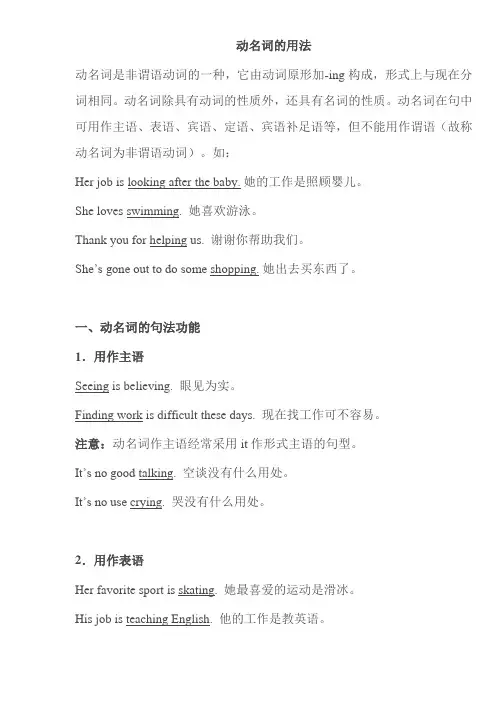
动名词的用法动名词是非谓语动词的一种,它由动词原形加-ing构成,形式上与现在分词相同。
动名词除具有动词的性质外,还具有名词的性质。
动名词在句中可用作主语、表语、宾语、定语、宾语补足语等,但不能用作谓语(故称动名词为非谓语动词)。
如:Her job is looking after the baby. 她的工作是照顾婴儿。
She loves swimming. 她喜欢游泳。
Thank you for helping us. 谢谢你帮助我们。
She’s gone out to do some shopping. 她出去买东西了。
一、动名词的句法功能1.用作主语Seeing is believing. 眼见为实。
Finding work is difficult these days. 现在找工作可不容易。
注意:动名词作主语经常采用it作形式主语的句型。
It’s no good talking. 空谈没有什么用处。
It’s no use crying. 哭没有什么用处。
2.用作表语Her favorite sport is skating. 她最喜爱的运动是滑冰。
His job is teaching English. 他的工作是教英语。
注意:不定式和动名词均可用作主语和表语,区别是:动名词多指笼统的、抽象的概念,而不定式则多指具体的、一次性的动作。
3.用作宾语She likes singing and dancing. 她喜欢唱歌跳舞。
He enjoys playing basketball. 他喜爱打篮球。
介词后出现动词时,通常要用动名词形式,不能用动词原形,通常也不用不定式。
Thank you for helping us. 谢谢你帮助我们。
He left without saying good-bye. 他没有告别就离开了。
4.用作定语This is our reading room. 这时我们的阅览室。
动名词如果一个动词加上了ing变成了名词,那么这个词称动名词。
由于动名词是由动词变化而来,它仍保留着动词的某些特征,具有动词的某些变化形式,用以表达名词所不能表达的较为复杂的意念。
动名词的名词特征表现在它可在句子中当名词来用,作主语、宾语、表语、定语。
它也可以被副词修饰或者支配宾语。
一、动名词的作用1、作主语1)直接位于句首做主语。
例如:Swimming is a good sport in summer.2)用it 作形式主语,把动名词(真实主语)置于句尾作后置主语。
动名词做主语时,不太常用it 作先行主语,多见于某些形容词及名词之后。
例如:It is no use telling him not to worry.3)动名词作主语与动词不定式作主语的比较:动词不定式和动名词都可以用作主语。
在意义上相近。
但动名词多用来表示泛指或抽象动作,不定式多用来表示特指或具体动作。
比较:Smoking is not good for health. It is not good for you to smoke so much.2、作表语动名词作表语时句子主语常是表示无生命的事物的名词或what引导的名词性从句。
表语动名词与主语通常是对等的关系,表示主语的内容,主语、表语可互换位置。
Your task is cleaning the windows. 你的任务就是擦窗户。
(Cleaning the windows is your task.)What I hate most is being laughed at. 我最痛恨的就是被别人嘲笑。
(Being laughed at is what I hate most.)3、作定语动名词作定语往往表示被修饰词的某种用途。
如:a washing machine=a machine for washing=a machine which is used for washing .4、作宾语例:We are thinking of making a new plan for the next term. 我们正考虑为下学期制定新的计划。
动名词动名词的作用:动名词是一种非谓语动词形式。
它是由动词原形+ ing 构成,同现在分词形式一样,动名词具有名词的性质,但同时又保留了动词的功能,仍可以带宾语或状语。
动名词与其宾语或状语一起构成动名词短语。
动名词(短语)在句中具有名词的作用,作主语、宾语(包括介词宾语)、表语和同位语,一般表示:①笼统或泛指的意思;②抽象或经常性动作;③已成为过去的动作。
1、作主语,谓语用单数形式:Checking the information is very important. 核实情况非常重要。
Knowing is one thing;doing is another. 知是一回事,做又是另一回事。
Waving one’s hand is to say “Goodbye”. 摆手表示“再见”。
Talking like that is not polite. 那样谈话不礼貌。
〖注〗动名词作主语的特殊情况(必须背下来)动名词做主语,有时先用it作形式主语,把动名词置于句末。
这种用法在习惯句型中常用。
如:It is no use/no good crying over spilt milk. 洒掉的牛奶哭也没用。
It is a waste of time persuading such a person to join us. 劝说这样的人加入真是浪费时间。
It was hard getting on the crowded street car. 上这种拥挤的车真难。
It is fun playing with children. 和孩子们一起玩真好。
There is no joking about such matters. 对这种事情不是开玩笑。
It’s no use waiting. There won’t be another bus. 等也没有用,再也没有车了。
It’s no good/use having a car if you can't drive. 如果你不会开车,有车也没有用。
非谓语动词语法:动名词的用法非谓语动词语法:动名词的用法1doing being donehaving done having been done动名词的基本用法:(1)主语:Saving is easier than doing.His coming here will be a great help.It is no use waiting here, he has left.There is no getting along with him.(简直无法和他相处)(2)表语:His job is keeping the hall clean as possible.Seeing is believing.(3)宾语:a. 动词宾语:He admitted taking the book.I do mind your smoking here.重磅要点:下列动词须跟动名词作宾语:admit, appreciate, avoid, complete, delay, deny, enjoy, fancy, finish, mind, practice, resent, risk, suggest, allow, permit...特注:以allow为例:allow + doing sth(动名词作宾语)。
但可以:Allow sb to do sth(不定式作宾补)。
这类动词常见如advise, allow, permit, recommend, etc.b. 作介词宾语:He left without saying goodbye to us.Im looking forward to meeting you.(to 在这里是介词)(4)定语:reading room swimming pool walking stick动名词时态:I am thinking of setting a new dictionary.(以后)He never talked to me about his having been in Paris.(以前)动名词语态:He doesnt like being flattered.I heard of his having been chosen to be the coach of the team.动名词复合结构:由名词全部格或物主代词与动名词构成。
动名词基本用法一动名词定义;动名词的构成形式为“动词+ ing”。
当动名词在句子中作主语时,其谓语动词必须用单数。
Seeing is believing .、眼见为实。
Do you mind my smoking here? 你介意我在这里抽烟吗?Staying with him made her very happy. 和他在一起使她感到非常快乐。
二动名词的否定式和时态、语态的变化1. 动名词的肯定和否定式为doing not + doing ;2. 动名词的时态分为一般式:doing 完成式: having done.3. 动名词的被动语态一般式:being done,完成式:having been done. He admitted not telling us the truth at last. 他最后承认没有和我们说实话。
Keep the medicine away from being touched by children.(被动式)This huge bridge succeeded in having been built up last month.(被动式)三动名词的用法(一) 动名词作用1 . 动名词作主语经常采用it作形式主语。
It’s no good talking. 空谈没什么用处。
It’s no use crying. 哭没有用。
It’s no use crying over spilt milk. 覆水难收。
2 作宾语He is considering changing a job. 他正在考虑换一份工作。
She can’t avoid meeting him. 她免不了要碰见他。
巧记这些动词后面只用动名词作宾语的动词:+doingKeep March gifts.(“保持三月礼物”)k—keep e—enjoy e—excuse p—practice ; --- Keep m—mind a—avoid r—risk c—consider h—can’t help ;---March g—give up i—imagine f—finish,feel like t—think of s—suggest ---gifts. 温馨提示:(1)以下动词后,只能接动名词作宾语而不能接不定式:如:admit, appreciate, avoid, consider, delay, enjoy, finish, keep, imagine, miss, practice, resist, risk, save, suggest, understand, pardon, can’t help, be worth doing等He admitted taking my dictionary. 他承认拿走了我的词典。
含有动名词的习惯用法在实际应用中,动名词有不少特殊句型和用法一.单个词语或短语后接动名词1.On+动名词=as soon asOn arriving at the village, he found it changed greatly.2.worth +动名词Whatever is worth doing at all is worth doing well.3.without so much as +动名词=evenShe went away without so much as saying good-bye.4.on the point of +动名词=be going to doThe firemen arrived just as the house was on the point of giving away.5.can’t help +动名词=be unable to refrain from doingHe couldn’t help laughing when he heard the funny story.6come near+动名词=almost doJohn came near falling off his bike.7feel like+动名词=want to doDo you feel like taking a walk with me?8for the purpose of +动名词=for the sake ofShe writes to a number of friends for the purpose of collecting used stamps.9.in the hope of +动名词=with a view to doingWe looked up many books in the hope of getting further information .10.lose no time in +动名词= begin doing at onceHe lost no time in keeping his promise.11.make a point of +动名词=take care not to omit doingYou must make a point of spelling correctly.12.be accustomed to +动名词= get used toI am not accustomed to being spoken like that.13. succeed in +动名词=manage to doChina succeeded in sending up another man-made satellite yesterday. 二.某些句型中接动名词14It is no use / good +动名词It is no good reading without thorough comprehension.15.There be no end to +动名词There is no end to changing society or nature.16.There be no +动名词=It is impossible to doThere is no holding back the wheel of history.练习:1.Susan couldn’t resist _____ her friends the secret.A tellingB to tellC to have toldD speaking to2. I hope you don’t mind _____ you all this.A. to tellB. to have toldC. to be tellingD. my telling3. She was afraid ____through the forest , for she was afraid ____her way.A. to walk, to loseB. of walking, of losingC. to walk, of losingD. of walking, to lose4. She didn’t remember _____him before.A. having metB. have metC. to meetD. to having met5. ______ to somebody, a British person often shakes hands with the stranger.A. IntroducingB. To introduceC. To be introducedD. On being introduced6. Tom is always forgetting ____off the TV set when he stops ____ TV.A. turning, watchingB. to turn, to watchC. turning, to watchD.To turn,watching7. What worried the child most was _____to visit his mother in the hospital.A. his not allowingB. his not being allowedC. his being not allowedD. having not been allowed8. She looks forward every spring to _____ the flower-lined garden.A. visitB. paying a visitC. walk inD. walking in9. She can’t help _____the house because she’s busy making a cake.A. to cleanB. cleaningC. cleanedD. being cleaned10. ---What do you think made Mary so upset?--- _______ her new bicycle.A. As she lostB. LostC. LosingD. Because of losingKey : 1-5 ADCAD 6-10 DBDAC。